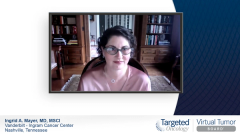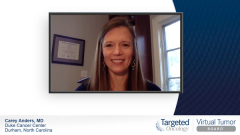
Case 1: Assessment of Risk of Recurrence in HER2+ Breast Cancer
Andrew Seidman, MD, follows the patient after TCHP therapy and discusses the risk of recurrence with the experts.
Episodes in this series

Sara Tolaney, MD, MPH: Andy, could you take us back to what happened to this patient who went on to get TCHP [docetaxel, carboplatin, trastuzumab, pertuzumab]?
Andrew Seidman, MD: Yes. The patient did complete 6 cycles of TCHP [docetaxel, carboplatin, trastuzumab, pertuzumab], and then had her definitive surgery. At the time of surgery, she had a 1.5-cm residual invasive carcinoma. Like the preoperative specimen, it was negative for hormone receptors and positive for HER2. And her nodes were negative, so she was staged as a ypT1c ypN0. She did have some residual disease, although remember her pretreatment tumor size was estimated at 4 cm. And she did have a positive FNA [fine needle aspiration] of an axillary node, so we know she was pathologically node-positive to begin with.
Sara Tolaney, MD, MPH: Andy, when you think about this particular patient who as you noted had a good response to therapy, though didn’t achieve a pCR [pathologic complete response], how are you thinking about what her potential risk of recurrence could be in this setting? Then how would you take that information and think about an adjuvant treatment decision?
Andrew Seidman, MD: I think about her residual risk based on some of the clinical trial data that informed this, such as KATHERINE. I don’t use the RCB [residual cancer burden] calculator frequently. I use the in-the-head calculator. The more positive nodes, the worse. The bigger the tumor, the worse. I’m fascinated by some new methods like the Neo-Bioscore calculation that was described recently, which accounts for both pre and post clinical and pathological variables. But we can safely say based on KATHERINE data that this patient’s risk of recurrence is significant, and the 3-year invasive disease-free survival data ranging from 77% to 88% puts this woman in a risk group that certainly warrants adjuvant therapy. And per KATHERINE, for me it would be Kadcyla [T-DM1, or trastuzumab emtansine].
Sara Tolaney, MD, MPH: I agree. Let’s pretend this patient goes on to get 14 cycles of T-DM1 [trastuzumab emtansine] based on the KATHERINE data. Ingrid, would you do anything else when she finishes the 14 doses of T-DM1? Would you consider something such as neratinib in this patient? To refresh everyone’s memory, this patient was hormone receptor-negative.
Ingrid A. Mayer, MD, MSCI: The short answer to your question is no. I probably wouldn’t do anything else. The data you’re referring to in terms of potentially considering neratinib for an extra year post-completion of your adjuvant HER2-targeted treatment, that trial was performed in an era where we didn’t have the dual antibodies. Trastuzumab was the only thing we had. We didn’t have T-DM1 [trastuzumab emtansine] in the adjuvant setting. We didn’t have pertuzumab in the neoadjuvant setting. A lot of those data do not apply in terms of the benefits seen in recurrence, let’s say below the neck. But the one thing that does intrigue me about the data is that there may be a protective effect on CNS [central nervous system] recurrences afforded by a small molecule such as neratinib. The problem is that obviously the numbers are small. I’m not sure we can rely on that, take that and run. But it’s certainly intriguing to see that fewer patients in the neratinib arm had CNS recurrences, at least numerically. Obvious there’s no power in the trial to say that convincingly. But numerically, there were fewer people recurring with CNS disease than not. I can tell you that the people today who I consider for addition of neratinib, regardless of ER/PR [estrogen receptor, progesterone receptor] status, I confess that I add it to patients with inflammatory disease. If you had HER2-positive disease and inflammatory cancer, I would throw the kitchen sink at them. Regardless of ER/PR status, they finish their HP [trastuzumab, pertuzumab], T-DM1 [trastuzumab emtansine], and I’ll add neratinib in there because it’s a different biology. They’re at such high risk of recurrence that anything I can get to improve their odds, I would do it. The other group for which I may consider adding neratinib despite pertuzumab and T-DM1 [trastuzumab emtansine], are patients for whom the residual cancer burden is ginormous. If they have more than 3 positive lymph nodes, big tumor, they had some response but not an optimal response, and they’re still at very high risk of recurrence, with tumors that are HER2-amplified and ER-positive, I would consider it there too, more for the sake of CNS recurrence protection than anything else. But it’s an area where we can argue this back and forth, and I’m not sure there’s a right or wrong answer. It’s not unreasonable to consider it for high-risk people, especially if they have ER-positive disease. But again, the point there is the gain you may have in CNS protection.
Sara Tolaney, MD, MPH: Certainly Carey, I know CNS is something you have thought about a lot. Would your decision here be similar, and how would that potentially change if this patient had hormone receptor-positive disease? Would that influence your decision for neratinib?
Carey Anders, MD: Sure. We were a bit surprised and disappointed that we didn’t see differences in CNS recurrences in KATHERINE. We may have anticipated better outcomes overall, and that we would have lower rates of CNS metastasis. But they were relatively similar in the T-DM1 [trastuzumab emtansine] and trastuzumab arm.
Exactly what Ingrid said; when I have a really high-risk patient and I am heavily concerned about recurrence, I’m going to try to maximize their duration of time on HER2-directed therapy. The unknown though is, in the ExteNET study, this was not post–T-DM1 [trastuzumab emtansine]. It was not post-trastuzumab, pertuzumab. It was post-trastuzumab. It’s hard to know what might cancel what out, and we just don’t know those data. There was about a 3% difference in the CNS recurrence rate for the patients with ER-positive, high-risk residual disease. I would consider it; I would discuss it. I have discussed it with a patient recently. We’re getting to that place.
Transcript edited for clarity.












































